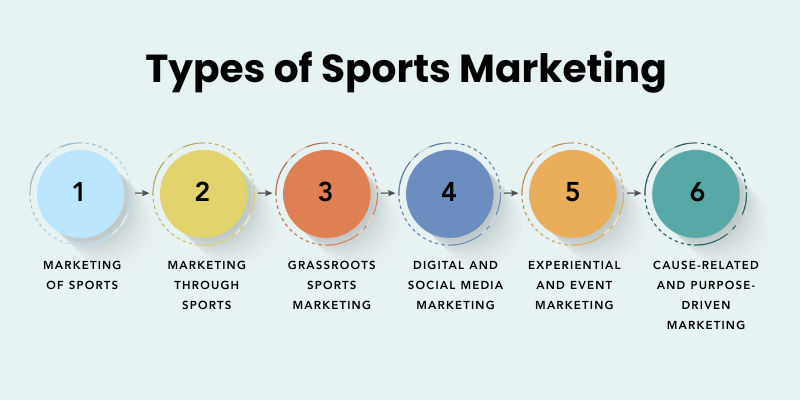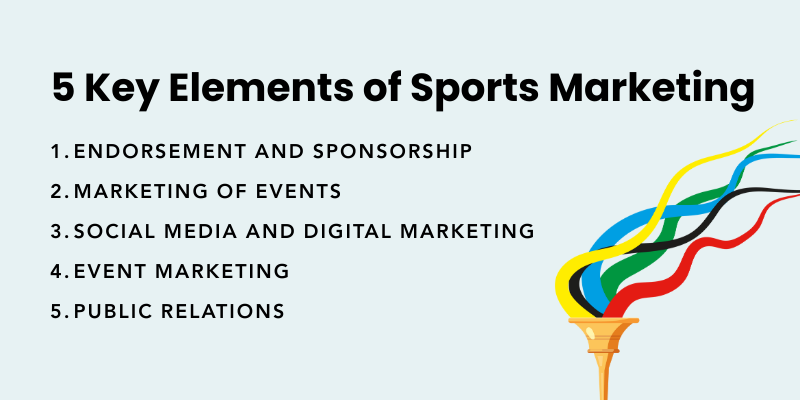Your alarm rings, signaling the start of your morning routine.
You slip into your Nike running shoes and Gymshark training shirt, preparing for your daily workout.
After completing your session, you fuel up with your favorite Huel protein shake as a post-workout meal, a key strategy often highlighted in growth marketing.
Do you notice a common theme? Every decision you made in this scenario is influenced by sports products, each of which has benefited from powerful marketing strategies.
So, what is sports marketing, and why does it play such a crucial role in the success of brands, especially in industries like entertainment marketing agency and performance marketing?
Sports marketing involves promoting products, services, or brands through various sports-related channels, often leveraging the influence of athletes, teams, or events.
In this article, we’ll dive deep into what sports marketing is, what it encompasses, who should use it, and how it can provide significant advantages for both athletes and businesses.
What is Sports Marketing?
Sports marketing is a specialized branch of marketing that focuses on promoting sports events, teams, athletes, and related products and services.
This field also leverages various online platforms, and companies often use digital marketing services and Enterprise SEO optimization services to enhance their reach and visibility.

It leverages the passion and loyalty of sports fans to create compelling marketing strategies. The field encompasses a wide range of activities, from advertising and sponsorships to community engagement and digital content creation.
Some brands also integrate best website builders for small businesses to create a strong digital presence while promoting their products alongside sports events.
Importance and Scope in the Global Market
The global sports industry is a significant economic sector, encompassing various facets such as professional leagues, media rights, sponsorships, merchandise, and fan engagement.
This blend of traditional sports marketing and advanced digital tactics shapes the industry's current and future potential.
Within just two months of the sneaker's release, $70 million worth of Air Jordans were sold, far exceeding initial projections.
This partnership revolutionized athlete endorsements and demonstrated the power of sports marketing in creating successful brand campaigns with best SEO company for e-commerce in the sports sector ensuring their products and events are discovered by relevant audiences, increasing both online visibility and sales.
Advertisement examples like this one highlight how powerful sports marketing strategies can be in driving sales and fan engagement.
Explore Our Digital Marketing Services!
6 Types of Sports Marketing
Sports marketing is a specialized branch of marketing that focuses on promoting sports events, teams, athletes, and related products and services.

We can split sports marketing into six key types:
1. Marketing of Sports
This approach focuses on promoting the sports themselves, such as leagues, teams, events, and athletes, to increase participation and viewership. It includes:
- Event Promotion: Marketing sports events like the Olympics or the Pro Kabaddi League to boost attendance and viewership.
- Team Branding: Developing and promoting the brand identity of sports teams to build a loyal fan base.
- Athlete Endorsements: Utilizing athletes to promote the sport and attract fans.
Examples include advertising campaigns for upcoming matches, ticket sales promotions, and team branding efforts.
2. Marketing Through Sports
This strategy uses sports platforms to promote non-sporting products or services. It includes:
- Sponsorships: Brands collaborate with sports teams, events, or athletes to boost visibility and credibility, helping in Google keyword ranking and SEO strategies.
- Product Placement: Integrating products into sports broadcasts or events.
- Brand Partnerships: Collaborating with sports entities to co-market products.
For example, Nike's long-term partnership with FC Barcelona, where Nike serves as the main shirt sponsor and uniform maker, benefiting both the brand and the team
3. Grassroots Sports Marketing
This type focuses on building relationships at the community level to promote sports participation and brand loyalty. It includes:
- Local Sponsorships: Supporting local teams and events to engage with the community.
- Youth Programs: Organizing programs to encourage youth participation in sports.
- Community Engagement: Creating initiatives that involve local communities in sports activities.
The NFL Foundation's Grassroots Program is an example, providing financial and technical assistance to neighborhood-based organizations to improve local football fields.
4. Digital and Social Media Marketing
With the rise of digital platforms, this type focuses on engaging audiences online. It includes:
- Social Media Campaigns: Using platforms like Instagram and Twitter to engage fans.
- Influencer Partnerships: Collaborating with influencers to promote sports-related content.
- Content Creation: Developing engaging content such as videos, blogs, and podcasts.
Brands are increasingly leveraging digital platforms to reach a broader audience and create interactive experiences for fans.
5. Experiential and Event Marketing
This approach focuses on creating memorable experiences for fans. It includes:
- Fan Engagement Activities: Organizing events that allow fans to interact with teams and athletes.
- Brand Activations: Setting up interactive booths or experiences at events.
- Live Events: Hosting events that provide immersive experiences for attendees.
For instance, brands like Aston Martin have created VIP experiences at Formula One events, offering luxury activities both on and off the track to engage customers.
6. Cause-Related and Purpose-Driven Marketing
This strategy aligns brands with social causes to build a positive image. It includes:
- Charity Partnerships: Collaborating with non-profit organizations to support causes.
- Awareness Campaigns: Running campaigns that highlight social issues.
- Community Support: Engaging in activities that support local communities.
Dove's partnership with Nike to promote body confidence in sports is an example of purpose-driven marketing, aiming to build girls' body confidence through sports.
Explore Our Performance Marketing Services!
5 Key Elements of Sports Marketing
Sports marketing leverages the passion and loyalty of fans to promote sports events, teams, athletes, and related products and services.

It encompasses a wide range of activities, from advertising and sponsorships to community engagement and digital content creation.
- Sponsorships and Endorsements: Brands collaborate with sports teams, events, or athletes to boost visibility and credibility.
- Social Media and Digital Marketing: Utilizing platforms like Instagram, TikTok, and Twitter, sports marketers engage fans with real-time updates, behind-the-scenes content, and interactive campaigns. This approach fosters a direct connection between teams and their audience, enhancing fan loyalty and engagement.
- Event Marketing and Experiential Campaigns: Organizing live events and interactive experiences allows fans to engage with the brand in memorable ways.
- Community Outreach and Fan Engagement: Engaging with local communities through grassroots initiatives and fan-centric programs builds long-term relationships and fosters brand loyalty.
How to Develop a Sports Marketing Strategy? Step-by-Step Guide
Developing a successful sports marketing strategy involves a series of structured steps to effectively promote sports events, teams, athletes, and products.
Here's a step-by-step guide:
1. Define Your Objectives
Set clear, measurable goals, such as increasing brand awareness, boosting ticket sales, or enhancing fan engagement. Ensure that your objectives align with your overall business strategy.
2. Understand Your Target Audience
Identify your core audience by analyzing demographics, psychographics, and fan behavior. Segment the audience to tailor your marketing messages effectively.
3. Conduct a Market Analysis
Research competitors, market trends, and conduct a SWOT analysis to identify opportunities and threats in the sports marketing landscape.
4. Choose the Right Channels
Select the best marketing channels, including traditional media, digital platforms, influencer partnerships, and sponsorships, based on your audience and goals.
5. Create Engaging Content
Develop compelling, audience-focused content such as videos, athlete stories, and user-generated content to engage fans and foster emotional connections.
6. Monitor, Adjust, and Build Long-Term Relationships
Track campaign performance through analytics, make necessary adjustments, and focus on sustaining fan engagement through loyalty programs and year-round interactions.
Top 5 Sports Marketing Trends for 2025 and Beyond
The future of sports marketing is being shaped by technological advancements that enhance fan engagement, personalize experiences, and expand the reach of sports content.

Here are some key trends to watch:
1. AI-Driven Personalization and Contextual Marketing
Artificial Intelligence (AI) is revolutionizing how brands engage with sports audiences.
AI-powered tools enable real-time contextual advertising, allowing marketers to tailor messages based on live game events, player performances, and fan sentiments, giving insight into how to measure brand awareness.
For instance, platforms like Seedtag utilize AI to deliver contextually relevant ads during sports broadcasts, enhancing viewer engagement and brand recall.
2. Phygital Sports and Hybrid Fan Experiences
The integration of physical and digital (phygital) sports is gaining momentum, blending traditional athletic competitions with virtual gaming elements.
Events like the "Games of the Future" exemplify this trend, where athletes compete in both physical and digital arenas, offering a multifaceted experience for fans.
This hybrid approach caters to diverse audiences, merging the excitement of live sports with the interactivity of digital platforms, thereby expanding the reach and engagement of sporting events.
3. Influencer and Athlete-Led Content Creation
Athletes and influencers are increasingly at the forefront of sports marketing, creating authentic content that resonates with fans.
Brands are collaborating with both high-profile athletes and emerging talents to produce engaging narratives, behind-the-scenes footage, and interactive sessions that foster deeper connections with audiences.
This trend reflects a shift towards more personalized and relatable marketing, moving away from traditional advertising models.
4. Immersive Technologies and Enhanced Fan Engagement
Virtual Reality (VR), Augmented Reality (AR), and wearable technologies are transforming fan experiences by offering immersive and interactive environments.
For example, VR tennis broadcasts are incorporating embedded visualizations and adaptive camera techniques to provide viewers with a more engaging and informative experience.
These technologies not only enhance the viewing experience but also open new avenues for fan interaction and participation, both in-stadium and remotely.
5. Diversification of Revenue Streams Through Digital Platforms
Sports organizations are expanding their revenue models by embracing digital offerings that go beyond traditional ticket sales and merchandise.
This includes launching subscription-based training programs, hosting virtual competitions, and providing exclusive digital content such as behind-the-scenes footage and athlete interviews.
These trends indicate a shift towards more personalized, interactive, and technologically advanced sports marketing strategies.
Explore Local Search Engine Marketing Company
Frequently Asked Questions
What is sports marketing?
Sports marketing is a branch of marketing that uses sports events, teams, or athletes to promote products, services, or brands. It leverages the popularity and emotional connection of sports fans to build brand awareness, fan loyalty, and revenue growth.
What are the main types of sports marketing?
Sports marketing can take different forms: promoting sports themselves (events, leagues, teams), using sports as a platform to advertise non-sports products (through sponsorships or endorsements), and grassroots marketing to boost community participation in sports.
Why do brands invest in sports marketing strategies?
Brands invest in sports marketing to tap into the passion and loyalty of sports fans, expand their reach, and drive sales — whether that means tickets, merchandise, or unrelated products promoted via sports.
How has digital marketing changed sports marketing?
Digital marketing — including social media, online content, and digital advertising — has expanded the reach of sports marketing, allowing brands and teams to engage fans constantly (not just around events), build communities, and deliver interactive fan experiences.
Who can benefit from sports marketing — businesses, teams or individuals?
Any organisation that wants to reach a passionate, engaged audience can benefit: sports teams or leagues looking to build fan base, brands seeking visibility through sports events, or even grassroots organisations aiming to encourage public participation in sports.
Conclusion
Sports marketing is a rapidly growing and influential field within the global economy.
The projected growth of the sports sponsorship market, expected to reach $115 billion by 2025 and surpass $160 billion by 2030, demonstrates its increasing importance.
This expansion is fueled by growing investments in talent, advanced analytics, and fan engagement, highlighting the sector’s ability to drive both audience connection and revenue generation.
As the industry evolves, sports marketing is set to embrace cutting-edge technologies like virtual and augmented reality, along with the rise of esports and digital platforms.
The demand for personalized fan experiences will also redefine how brands interact with audiences, making it more essential than ever for sports marketers to adapt.
Ultimately, what is sports marketing? It is an ever-evolving strategy that continuously innovates to stay connected with diverse fan bases and maintain its influence in the global market.









